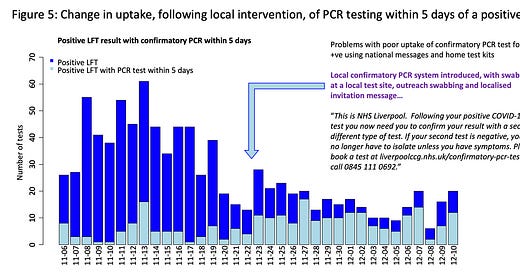Welcome to Plugging the Gap (my email newsletter about Covid-19 and its economics). In case you don’t know me, I’m an economist and professor at the University of Toronto. I have written lots of books including, most recently, on Covid-19. You can follow me on Twitter (@joshgans) or subscribe to this email newsletter here.
In November, 2020, the city of Liverpool in the United Kingdom was the place for an experiment in mass testing of their population for Covid-19. A combination of PCR tests and rapid antigen screens were deployed. The results are now out and I wanted to just make some observations regarding what was learned.
First of all, what was the take-up from the population of almost 500,000. There were about 219,000 lateral flow tests completed and 107,000 PCR tests. 190,000 people were tested. The total number of positives was 4,498.
One interesting issue related to confirmatory PCR tests. When someone tested positive with a rapid test, the idea is that they would obtain a PCR test as confirmation. But there was poor uptake of these. They tried to use messages and also take-home options but it remained an issue. This is relevant graph:
Clearly interventions helped here. But it shows that these things cannot be taken for granted.
Once again, the ability of rapid tests to detect infectiousness as opposed to infection was confirmed. Importantly, this was in a real-world rather than a clinical environment.
Third, the rapid tests varied in quality. Thus, a take-a-way is that it was important to record and evaluate the batch as well as the type of test people were getting so as to identify production issues.
Finally, as testing is voluntary, the survey responses of attitudes of people who did and did not take part were instructive.
There was a correlation between a belief in the risks of Covid-19 and participation and also in attitudes towards self-isolation which is a critical response to being tested positive. The report doesn’t show if these types of attitudes were themselves correlated.
There is also some indication of a change in behaviour but it is hard to rely on the magnitudes given that it was all self-reported.
The report also has details of demographic issues but, at this stage, I am not sure what to make of them as too much else could be going on.
Overall, there is evidence the pilot had a large impact on prevalence of Covid-19 in the region. But, as with Slovakia, one suspects these effects will be short-lived.
In many respect, this confirms many of our prior beliefs about this. The challenge is to set up a system that will be sustainable. Once off interventions, unless they are far stronger in scope, are unlikely to be sufficient to curb the pandemic.








